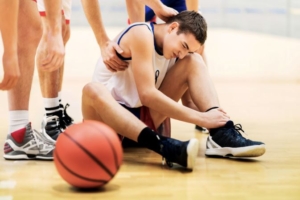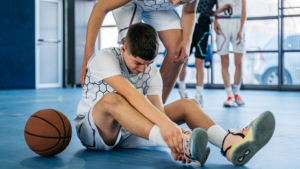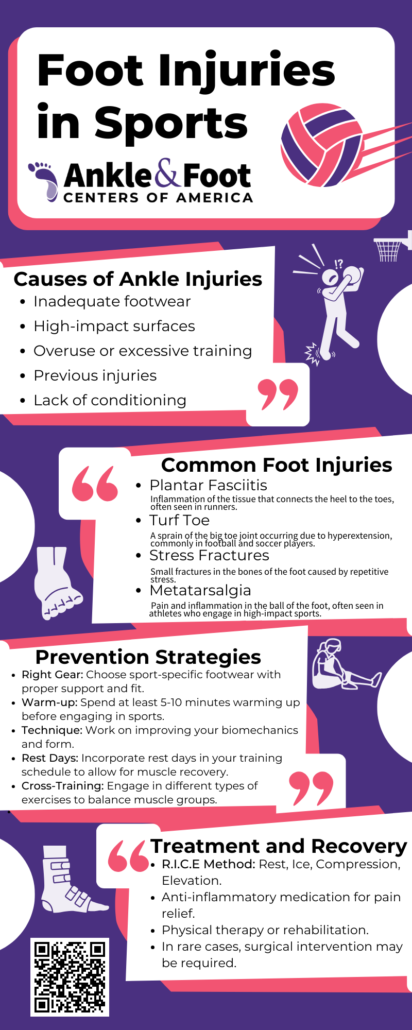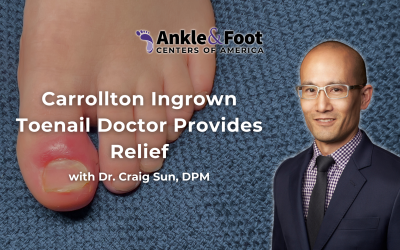Table of Contents
Uncovering the Most Common Foot Injuries from Sports
Are you an athlete who’s tired of being sidelined by foot injuries from sports? No need to fret! We’ve got you covered with an insightful guide to uncover the most common causes of foot injuries in sports and how to deal with them effectively. Get ready to discover the secrets to staying injury-free and maintaining peak performance!
Key Takeaways
- Understand the causes of sport-related foot injuries and take preventive measures to reduce risk.
- Take proactive steps to prevent common foot injuries, such as plantar fasciitis, ankle sprains, stress fractures & more.
- Manage and recover from any existing injury with rest, rehabilitation exercises & professional guidance for best results!
Sport-Related Foot Injuries: An Overview
 Foot and ankle injuries are a huge setback for athletes, leading to immense pain and having them take time off from their favored sports. These types of damage include plantar fasciitis, stress fractures, as well as the most frequent type: Ankle sprains. But what are the factors behind these incidents? And how can one prevent themselves in order not to succumb to such an injury?
Foot and ankle injuries are a huge setback for athletes, leading to immense pain and having them take time off from their favored sports. These types of damage include plantar fasciitis, stress fractures, as well as the most frequent type: Ankle sprains. But what are the factors behind these incidents? And how can one prevent themselves in order not to succumb to such an injury?
The actions that come with playing multiple sports – mainly running- impact feet causing foot pains or more severe difficulties like other mentioned issues above. Due its force on feet making humans vulnerable when engaging physical activities intensively without paying attention . If individuals understand this dynamic they may be able decrease their risk while continuing performing at high standards by taking preventive steps before being injured. So let’s explore Into sport related matters which involve our feet!
Plantar Fasciitis in Athletes
Pain in the heel, often described as stabbing and mainly occurring after walking or standing for extended periods of time is a common issue amongst athletes due to plantar fasciitis. This condition involves inflammation of the fibrous tissue which connects from your heel bone right through to your toes known as ‘plantar fascia’.
To stop this recurring pain it’s important you have adequate foot support, keep up with healthy weight levels while also slowly increasing any running intensity/distance that you do engage in, if only beginning out.
If painful symptoms are already present there are still ways to reduce them: comfortable shoes providing good arch support should be used alongside avoiding triggers aggravating Issues. Strengthening lower leg muscles together with exercises & stretches will benefit not only your feet but lessen discomfort too!
Ankle Sprains and Sports
 Ankle injuries, such as sprains, are common among athletes who participate in sports that require rapid direction changes or involve uneven surfaces. This type of injury happens when the foot is forced into a position it isn’t supposed to be in. Ligaments tear and stretch too far resulting in acute pain, inflammation and instability of the ankle. To reduce one’s chances of an ankle sprain from occurring proper warm-up exercises focusing on balance should be done along with wearing supportive ankles braces during activities. In case one does have a severe sprain, RICE (resting affected area/limb – icing regularly – compressing using bandage wraps – elevating limb) protocol can help manage it but more serious cases may need additional treatment which might include compression boots for stabilization or crutches so no weight goes through injured region while healing takes place.
Ankle injuries, such as sprains, are common among athletes who participate in sports that require rapid direction changes or involve uneven surfaces. This type of injury happens when the foot is forced into a position it isn’t supposed to be in. Ligaments tear and stretch too far resulting in acute pain, inflammation and instability of the ankle. To reduce one’s chances of an ankle sprain from occurring proper warm-up exercises focusing on balance should be done along with wearing supportive ankles braces during activities. In case one does have a severe sprain, RICE (resting affected area/limb – icing regularly – compressing using bandage wraps – elevating limb) protocol can help manage it but more serious cases may need additional treatment which might include compression boots for stabilization or crutches so no weight goes through injured region while healing takes place.
Stress Fractures in Sports
Stress fractures are tiny breaks in the bone, usually resulting from regular strain or overwork. Athletes commonly experience this type of injury due to extensive training and bad fitting shoes. There are two main forms that require attention. Metatarsal stress fracture and navicular stress fracture. It is necessary for both prevention and healing purposes to have a thorough understanding of these different types as well as what causes them.
The importance of proper treatment cannot be emphasized enough when it comes to injuries such as stress fractures which can all too easily become chronic if not managed correctly.
Metatarsal Stress Fractures
Stress fractures of the metatarsal bones, resulting from overuse and excess pressure put on the foot, are an all-too-familiar injury among runners. If you want to avoid this painful problem caused by intense physical activity like running or jumping, it is crucial that training intensity be gradually increased and proper footwear worn at all times. When already faced with such a fracture due to repeated force application upon your feet, visiting a medical professional for evaluation could help as well as taking off any strain being put onto your sole and making sure vitamin D levels stay in check.
Navicular Stress Fractures
Stress fractures of the navicular bone often occur due to overtraining or nutrient deficiencies and can be very painful if not treated correctly. Fortunately, there is a solution for those suffering from this type of injury – immobilization followed by slowly increasing strength-building exercises should help get you back on your feet in no time! Proper treatment will ensure that any long term damage caused by the fracture does not occur. It’s important to give these kinds of stress fractures special attention so they don’t cause lasting issues down the line.

Achilles Tendon Injuries
When it comes to injuries of the Achilles tendon, minimizing risk is essential. This can be done by regularly performing stretching and strengthening exercises as well as avoiding excessive and repetitive stress used on this particular area. If a tear or inflammation still occurs due to overuse, improper warm-up routines or ill-fitting footwear, treatment for foot injuries should include rest periods with ice packs applied for compression along with elevation where applicable – physical therapy may even need to be incorporated in more extreme cases. If necessary surgery could also potentially provide relief from pain and injury.
Turf Toe and Other Toe Injuries
Injury to the big toe joint, also known as turf toe, can be a result of extending or forcing it beyond its normal range. This kind of trauma may cause severe discomfort and even disable athletes for weeks or months. Prevention is key: wearing proper shoes with toes taped up properly along with strengthening exercises are an effective way to protect from these unpleasant injuries caused by too much pressure on the toes. In this case preparation is essential if one wants avoid excessive pain associated with such injury like turf toe and keep playing!
Shin Splints and Sports
Shin splints are a very common issue in sports that require frequent impact on the legs, like running and jumping. It is characterized by intense pain and tight calf muscles as well as inflammation along the inner side of your shinbone which can be tremendously debilitating to athletes’ performance.
To avoid having issues with this condition it is recommended to always wear proper footwear and do stretching exercises for flexibility while also doing strength training routines focusing mainly on balancing all lower leg muscles. If you already have suffered from shin splints there exist various forms of treatment options available such us RICE protocol, anti-inflammatory medications or physical therapy sessions aimed at reducing pain intensity plus decreasing swelling together with increasing muscular mass simultaneously around the area affected (lower part of your leg).
Risk Factors and Prevention Strategies
Identifying the causes of foot injuries in sports is a sure way to help athletes remain injury-free. Commonly noted risk factors include height and weight, inadequate physical conditioning, footwear that doesn’t fit properly or is worn out as well common injuries such as muscular disparities. These elements can all contribute to an increased threat for sustaining these types of injuries while playing sports.

To counter this danger, preventive techniques should be applied. Suitable shoes being at the top list along with proper warm up routines prior exercising and gradually rising intensity levels when training are key measures towards minimizing chances for any such incident taking place during activities requiring feet coordination movements: hence preserving good health habits & enabling players continue their competitive endeavors undisturbed by harm inflicted upon themselves due negligence on foresight matters!
Managing and Recovering from Foot Injuries
 To ensure a swift recuperation from issues involving the foot and ankle, incorporating adequate rest together with rehabilitation exercises are essential. Utilizing the RICE first-aid approach and consulting a sports medicine professional can be beneficial in helping to prevent future injuries while tackling existing ones as well.
To ensure a swift recuperation from issues involving the foot and ankle, incorporating adequate rest together with rehabilitation exercises are essential. Utilizing the RICE first-aid approach and consulting a sports medicine professional can be beneficial in helping to prevent future injuries while tackling existing ones as well.
Strengthening muscles, improving joint stability via balance training activities alongside physical therapy can help reduce pain, swelling and overall improve performance for those managing their own recovery plan. Foot problems need not hold you back if one takes an active stance towards regaining fitness!
Summary
Foot injuries are often common in sports, but by addressing and comprehending the risk factors as well as deploying preventive measures to manage them effectively, foot pain can be abated so that athletes may strive for their best performance. To succeed at your sport of choice and stay injury-free on the field, court or track – identifying these most usual types of foot troubles is essential!
Frequently Asked Questions
What are the most common foot injuries in athletes?
When it comes to common foot injuries, athletes need to be aware of the warning signs. These can include Achilles Tendonitis, Plantar Fasciitis, Stress Fractures, Heel Spurs and Ankle Sprains, all of which should not be overlooked or ignored as they may lead to more serious issues if left untreated. Foot health is imperative for sports players. Understanding how these different ailments work and when immediate medical help is required could prevent Damage from occurring due a range of ankle or heel related problems.
What are the 8 common foot injuries?
Having healthy feet is important for one’s overall well-being, and injuries to the foot can occur from a variety of sources. Stress fractures, ankle sprains, neuromas as well as heel spurs are all common issues that should not be ignored when it comes to your foot health.
Bunions and sesamoiditis may also cause pain in the lower area while Achilles tendinitis could mean trouble if left untreated or unrelieved over time. Taking care of your ankles and feet with appropriate shoes paired alongside regular stretching will help you prevent any sorts of injury that might arise later on due to neglecting them now.
How do I know if my foot injury is serious?
If your foot is misshapen following a new injury, you have severe pain or swelling, an open wound, signs of infection such as redness and warmth, you can’t put any weight on it, or if your foot is icy cold and pale or blue, you should seek help as this may be a serious foot injury.
What is plantar fasciitis, and how can I prevent it?
The plantar fascia is the cause of stabbing heel pain, which occurs when it has become inflamed and results in Plantar Fasciitis. To protect oneself against this issue, wearing shoes with good support should be a priority as well as maintaining weight balance while slowly increasing running distance and intensity. In summary, take care to prevent irritating your heel due to an inflammatory reaction from overworking the tissue surrounding it known as plantar fasciitis.
How can I prevent ankle sprains in sports?
Before playing sports, take protective measures to safeguard your ankle: warm up first, then practice balancing activities and wearing an appropriate brace for Prevention of injury.





